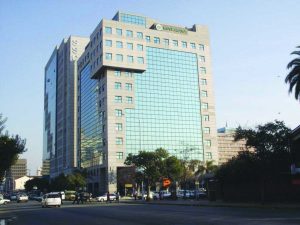

THE National Social Security Authority (Nssa) says it has failed to introduce any new safety-net schemes over the past 27 years due to economic instability in Zimbabwe.
An International Labour Organisation (ILO) convention in 1952 set minimum standards for social security outlining nine focus areas, of which only four are covered in Zimbabwe.
“There has been stagnant social security growth. For the past 27 years we haven’t managed to introduce any new schemes,” Nssa deputy director for social security Tambudzai Jongwe told a media workshop last week.’

The National Social Security Authority building
In terms of the ILO framework, the four categories covered in Zimbabwe are old age, survivor, invalidity and employment injury.
The five outstanding areas are health-care, sickness, unemployment, family benefit and maternity.
“Our wish is that we extend to the five remaining contingencies so that we have more comprehensive social protection in Zimbabwe, but the economic challenges that the country has faced over the past two decades is one of the main hindrances why we haven’t been able to extend our branches of social security,” Jongwe said.
“But as things stabilise, I am sure we will venture into other contingencies that we are not currently covering,” she added.
Zimbabwe also faces the problem of social security exclusion.
Nssa schemes are contributory, covering 24 percent of the working populace leaving 76 percent of the informal sector workers vulnerable.
The number of contributing companies and employees has also been dwindling owing to company closures and retrenchments.
“The country seeks to extend social security coverage, both in terms of the number of contingencies covered (vertical coverage), as well as in terms of the coverage of demographic cohorts (horizontal coverage). The authority has seen the compelling need to extend social security coverage to workers in the informal sector, who constitute 76 percent of the employed labour force,” Jongwe said.
“We are working with ILO for the technical guidance and we are hoping that by the 2022 first quarter, we will have a fully-fledged voluntary informal sector scheme running.”
Meanwhile, Nssa has been reviewing pensions on a quarterly basis this year to keep up with inflation. Presently, the minimum monthly retirement pension is the ZW$ equivalent of US$35 for the Pension and other Benefits Scheme (POBS) and US$45 for Accident Prevention and Workers’ Compensation Scheme (APWCS) at Reserve Bank of Zimbabwe exchange/auction rate.
“The authority aims to progressively increase the figure to the equivalent of US$60 by end of this year in line with the World Bank international poverty datum line of about US$2 per day,” Jongwe said.
Nssa says it has sought to augment the statutorily stipulated monthly pension pay-outs with non-monetary benefits.
“It (Nssa) has paid grocery allowances to all pension beneficiaries under the two schemes, the POBS and the APWCS. A total of 228 932 POBS and APWCS beneficiaries have been paid grocery allowances,” Jongwe said.
Nssa was established in October 1994, with the mandate of administering and managing social security in Zimbabwe.
newsdesk@fingaz.co.zw